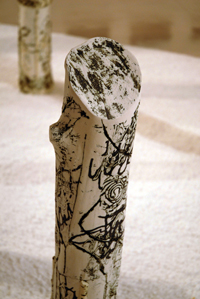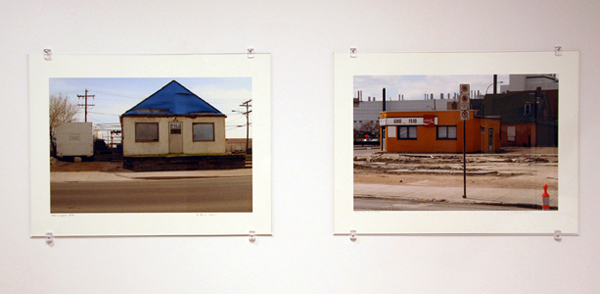 Grace Nickel website William Pura website List of works Back to first page  ABOVE FOREGROUND: Grace Nickel's Devastatus Rememorari ABOVE BACKGROUND: William Pura's Logan Avenue photographs PHOTO CREDIT: Bob Talbot Gallery One One One is very pleased to present this summer exhibition of work by faculty members William Pura, who has been on the staff of the School of Art for many years, and Grace Nickel, who has just joined the ceramics area. As a curator I have brought together these two bodies of work for poetical reasons. Both works are, in a way, memorials. Each is an elegiac meditation on the intersection of city and country. GRACE NICKEL Devastatus Rememorari (devastation remembered) is Grace Nickel's meditation on Hurricane Juan's 2003 destruction of Point Pleasant Park in Halifax, Canada. Grace describes her inspiration and process for the work in this way: Using porcelain, I am attempting to rebuild the trees by making casts of the demolished remnants. In my reclaimed ceramic trees, organic motifs and text are embedded in the trunks or applied to the surfaces of the segments that are being pieced together in a symbolic attempt to help mend the ravaged trees. The reconfigured ceramic forms embody traces of the trees' history and stand as memorials to loss. At the same time, in my efforts to reconstruct them in clay, and by creating a new textual "bark" for the trees, I also acknowledge the potential for regeneration and recovery.  ABOVE: a detail of Grace Nickel's Devastatus Rememorari PHOTO CREDIT: Bob Talbot My first encounter with this installation brought to mind the seafaring art of scrimshaw, a whaler's craft in which designs are scratched into marine ivory. The work also recalls paintings by Canadian First World War artists (some of whom would later become Group of Seven artists) of devastated land, which, like Nickel's pieces, are beautiful. I know Point Pleasant Park very well. In my childhood I thought of it as a towering forest, which it is, and not as a cultivated park, which it also is. For a child, its rolling pathways hid a surprise around every corner: a squirrel, a fiddlehead or an ice cream vendor. For me the enchantment was the park's "almost" wildness; although completely surrounded by trees, one was always close to the safety of civilization. I have fond memories of my Point Pleasant Park hideaways, and so I felt badly for Halifax when Hurricane Juan did its damage in 2003. I am old enough to remember how the very idea of a memorial work of art in honour of mere trees would be incomprehensible, but there are reasons why such a work is easily understood now. Like many a memorial -- I think again of World War I -- grief is aggravated by a vague sense of one's own responsibility for the disaster. I'm not sure how rational that sentiment is, but the logic works this way: if global warming is our fault and it makes hurricanes, then we must share the blame for this "natural" disaster. This puts Hurricane Juan in the same category as Halifax's 1917 Halifax explosion, the disaster against which every new calamity in Halifax is measured. The ancient function of memorial sculpture is repurposed in this work, as if Nickel were making tree trunk cremation urns laden with a family scrapbook of inscriptions. WILLIAM PURA William Pura is a painter, printmaker and composer. The ten digital prints in this exhibition are excerpts from a vast and ongoing study of Winnipeg's Logan Avenue that the artist began in 2005. Logan Avenue is a mixed-use strip that starts in Winnipeg's Chinatown and barrels straight out to the prairie at the Oak Point Highway. The street honours either Robert Logan (1773-1866), or Winnipeg mayor Alexander Logan (1841-1894), an indication of great age in a place in which some archaeological sites refer to anything before 1870 as "pre-history."  ABOVE: Two of William Pura's Logan Avenue photographs installed at Gallery One One One PHOTO CREDIT: Bob Talbot This street needs intervention, care, and some urban planning, and Pura's photographs amount to an elegant plea for help. He took the pictures as a "drive by shooter" using a special table-mounted camera that he constructed himself for his van. Ed Ruscha's Every Building on the Sunset Strip bookwork comes to mind as a precedent, but Pura, unlike Ruscha, and without the visible presence of people, is looking for evidence of human interventions that are slightly unusual or unexpected, that certain photographic punctum that catches the attention within what might otherwise be a simple inventory of buildings. William Pura says: Like my other images of the city, the human presence in these photographs is alluded to but not depicted in an obvious way. And like my earlier work, light, as defined by both natural and artificial sources, is an important element in defining the drama that is found in the relationships of the architectural and the natural environment. Starting from the old downtown near the Red River, Logan Avenue stretches northwest through a variety of residential neighbourhoods, old and new industrial areas and finally ends in the transportation hub of the modern Prairies: the trucking industry and Winnipeg International Airport.Several things are likely to strike a viewer as they spend time with these pictures. Firstly, Logan Avenue is not a wealthy street. It has the character of a former residential area that, piece by piece, has been taken apart, destroyed and partially rebuilt. Odd bits of vacant land are scattered along it. Somehow a large steel billboard has collapsed and been left undisturbed. In a signature photograph from the series, a cross hangs near a mailbox that has been overturned by some young thug (these things are too heavy for the wind to topple). Signs of neglect abound, but so do efforts at sentiment, for example the Christmas lights that adorn some of the houses in Pura's works. |